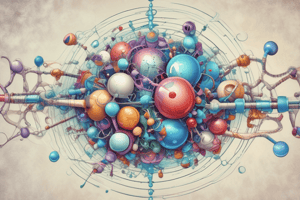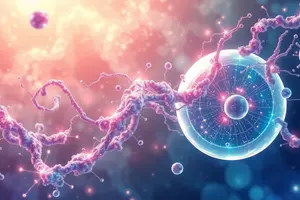Podcast
Questions and Answers
What is indicated by a low therapeutic index (TI)?
What is indicated by a low therapeutic index (TI)?
- The drug is highly effective in small doses
- The drug effect should be closely monitored due to toxicity risk (correct)
- The drug has a wide margin of safety
- The drug is safe for use without supervision
What does the term pharmacodynamics refer to?
What does the term pharmacodynamics refer to?
- The study of drug manufacturing processes
- The analysis of drug interactions and side effects
- The branch of pharmacology focusing on drug action mechanisms (correct)
- The examination of drug absorption and distribution in the body
How is the therapeutic index (TI) calculated?
How is the therapeutic index (TI) calculated?
- TI = LD50 / ED50 (correct)
- TI = ED50 + LD50
- TI = ED50 x LD50
- TI = ED50 - LD50
What does ED50 represent?
What does ED50 represent?
What occurs during the pharmacodynamic process of drug action?
What occurs during the pharmacodynamic process of drug action?
What is the therapeutic range for Carbamazepine?
What is the therapeutic range for Carbamazepine?
Which of the following statements about onset of action is true?
Which of the following statements about onset of action is true?
Which type of drug-receptor interaction produces a response?
Which type of drug-receptor interaction produces a response?
Which receptor type involves a signaling mechanism that activates an enzyme inside the cell?
Which receptor type involves a signaling mechanism that activates an enzyme inside the cell?
What is the primary function of chemotherapeutic agents?
What is the primary function of chemotherapeutic agents?
Which parameter does NOT evaluate drug action within a time-response curve?
Which parameter does NOT evaluate drug action within a time-response curve?
What characterizes a drug that is more potent?
What characterizes a drug that is more potent?
Which of the following is a characteristic of nuclear receptors?
Which of the following is a characteristic of nuclear receptors?
What happens when a drug binds to G protein-coupled receptors?
What happens when a drug binds to G protein-coupled receptors?
When comparing drugs by efficacy, what is being measured?
When comparing drugs by efficacy, what is being measured?
Flashcards are hidden until you start studying
Study Notes
Pharmacodynamics Overview
- Pharmacodynamics defines the relationship between drug concentration and physiological responses in the body.
- It involves the mechanisms of drug action within living tissues, focusing on how drugs interact with receptors.
Mechanism of Drug Action
- Drugs bind to specific receptors, activating cell signaling pathways, leading to physiological responses.
Therapeutic Index (TI)
- TI is a ratio estimating a drug's safety margin, calculated as TI = LD50/ED50.
- ED50: Effective dose in 50% of a population.
- LD50: Lethal dose in 50% of a population.
- A lower TI indicates a narrow safety margin, requiring close monitoring; a high TI indicates a wider margin and lower toxicity risk.
Therapeutic Range
- Refers to the concentration between minimum effective plasma concentration and minimum toxic concentration.
- Example:
- Carbamazepine therapeutic range: 6-12 mcg/ml; toxic >12-15 mcg/ml.
- Phenytoin therapeutic range: 10-20 mcg/ml; toxic >30 mcg/ml.
Dose-Response Relationship
- The dose-response relationship measures the effects of varying drug dosages on response.
- Onset of Action: Time to reach minimum effective concentration after administration.
- Peak Action: Maximum plasma concentration of the drug.
- Duration of Action: Length of time the drug produces a pharmacologic effect.
Graded Dose-Response Relationship
- Potency refers to the amount of drug needed for a therapeutic effect; more potent drugs act at lower doses.
- Efficacy is the maximum response produced by a drug.
- The relative importance of potency vs. efficacy in pharmacotherapy varies by situation.
Drug Mechanisms
- Drugs can function in several ways:
- Replace or supplement missing chemicals.
- Increase certain cellular activities.
- Inhibit or slow down cellular activities.
- Interfere with foreign cell functions (e.g., chemotherapy).
Receptor Theory
- Drugs exert effects by binding to specific receptors which may initiate or block physiological responses.
- Drug activity is reliant on the affinity for specific receptors.
Receptor Families
- Kinase-linked Receptors: Cell surface receptors activating intracellular enzymes upon binding.
- Ligand-gated Ion Channels: Receptors that open channels for ion flow, mainly sodium and calcium.
- G Protein-Coupled Receptors:
- Involves interaction with G proteins and downstream effectors, either enzymes or ion channels.
- Nuclear Receptors: Located in the nucleus, modulating gene expression and producing extended responses.
Types of Drug-Receptor Interactions
- Agonists: Drugs that activate receptors to produce a response (e.g., bethanechol).
- Antagonists: Drugs that block receptor activation without producing a response.
Studying That Suits You
Use AI to generate personalized quizzes and flashcards to suit your learning preferences.




